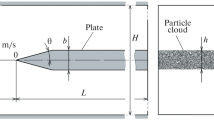Summary
Results are given for the flow of particles, and of the associated air, through orifice plates and shaped nozzles in the side of an air fluidised bed. These data, and other data published by previous workers, indicate that the solids flow can be predicted by treating the fluidised solids as an inviscid liquid and applyingBernoulli's theorem. This leads to a simple result, accurate enough for design purposesM=π r e 2 C D ϱ0 (2g H 0)1/2.
For the orifice plates the discharge coefficientC D is about 0.5; for the shaped nozzles the discharge coefficient approaches unity for longer nozzles. Although these results indicate behaviour closely analogous to that of a liquid, detailed study of jet trajectories indicates a velocity coefficient of somewhat less than unity (of order 0.5–0.7) for orifice plates, associated with a contraction coefficient of about unity.
The differences from liquid behaviour of the particle jet may be due to the associated air flow which has two components:
-
1.
Air is entrained in the voids between the outgoing particles, the voidage fraction in the jet being somewhat greater than the voidage at incipient fluidisation.
-
2.
Additional air percolates through the interstices, and its flow can be predicted approximately fromDarcy's law.
The total efflux of air with the particle jet is markedly reduced by lengthening the shaped nozzles, because component [2] is reduced on account of the greater path length for percolating air.
Similar content being viewed by others
Abbreviations
- A :
-
nozzle cross-section at distancex from nozzle exit
- A e :
-
nozzle cross-section at nozzle exit
- B :
-
arbitrary constant
- C A :
-
contraction coefficient (area)
- C D :
-
discharge coefficient=M/π r e 2ϱ0 (2 g H0)1/2
- C v :
-
velocity coefficient=v e/(2g H0)1/2
- G s :
-
solids mass velocity through nozzle (Stemerding et al.)
- g :
-
acceleration due to gravity
- H 0 :
-
height of fluidised bed above orifice at incipient fluidisation
- K :
-
constant inDarcy's law
- K 2 :
-
constant (Massimilla et al.)
- M :
-
solids mass discharge rate
- m i :
-
solids mass discharge rate at levelY i
- P :
-
pressure fromBernoulli's equation
- p f :
-
interstitial gas pressure
- p H :
-
pressure drop across the bed above the orifice at incipient fluidisation
- p p :
-
pressure equivalent to interparticle forces
- Q e :
-
total gas discharge rate=Q p+Qa
- Q p :
-
gas flow due to entrainment
- Q a :
-
gas flow due to percolation
- Q s :
-
volume flow rate of solids (Massimilla et al.)
- r :
-
radius of hemisphere based on nozzle centre
- r e :
-
radius of orifice or nozzle exit
- U 0 :
-
superficial gas velocity at incipient fluidisation
- U a :
-
superficial velocity of extra air at exit=Q a/πrine2
- u, u e :
-
interstitial gas velocity, and at exit
- u 0 :
-
value ofu at incipient fluidisation
- v, v e :
-
particle velocity, and at exit
- ¯v e :
-
mean measured value ofv e
- v i :
-
exit particle velocity deduced from trajectory measurements
- X :
-
length of nozzle
- x :
-
axial distance from nozzle exit
- Y, Y i :
-
vertical fall of a segment of particles
- z :
-
horizontal distance from exit
- ε :
-
voidage fraction of the bed
- ε e :
-
voidage fraction of the particle jet at exit
- ε 0 :
-
voidage fraction at incipient fluidisation
- ϱ 0 :
-
bulk density of bed at incipient fluidisation
- ϱ s :
-
density of solid particle
References
Massimilla, L., V. Betta andC. D. Rocca, A. I. Ch. E. Journal7, 502 (1961).
Stemerding, S., J. H. de Groot andN. G. M. J. Kuypers, Fluidisation. Symposium of the Society of Chemical Industry held 1963 (1964).
Volpicelli, G., Solid discharge from fluidised beds of particles. Private communication. Istituti di Chimica Industriale e d' Impianti Industriali Chimici del' Università (Napoli 1964).
Davidson, J. F. andD. Harrison, Fluidised Particles (Cambridge 1963).
Massimilla, L., Private communication 1965.
Author information
Authors and Affiliations
Rights and permissions
About this article
Cite this article
Jones, D.R.M., Davidson, J.F. The flow of particles from a fluidised bed through an orifice. Rheol Acta 4, 180–192 (1965). https://doi.org/10.1007/BF01969254
Received:
Issue Date:
DOI: https://doi.org/10.1007/BF01969254



